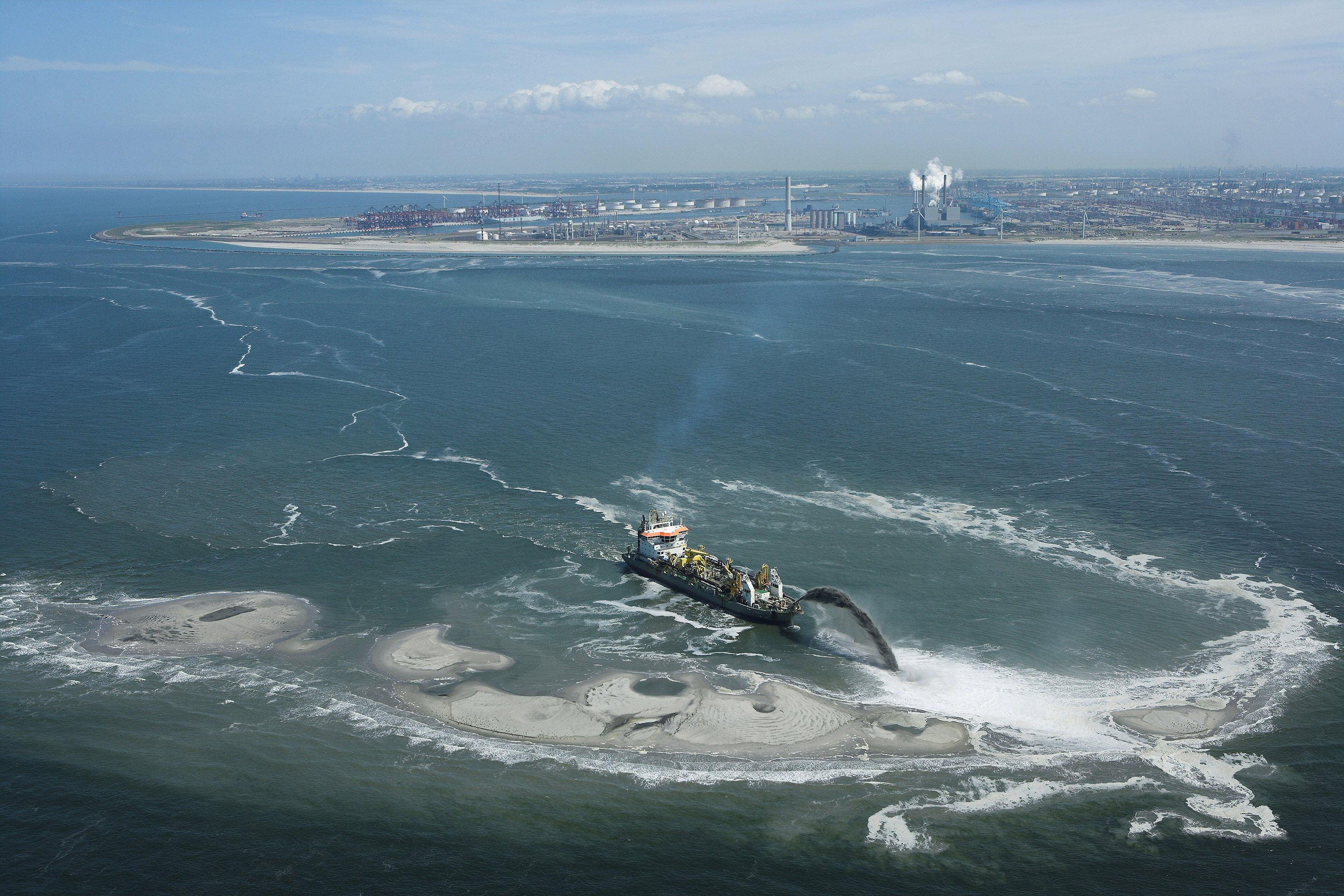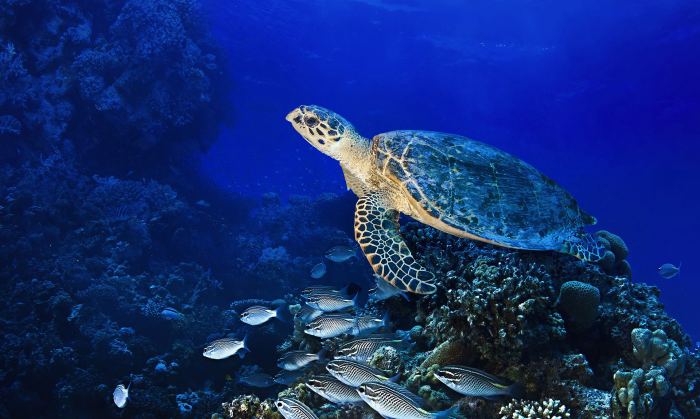Port of Rotterdam’s COO Ronald Paul reflects on one of the largest port extensions in history
Many people worldwide have heard about Maasvlakte 2 — a hugely ambitious € 2 billion port extension project in the Port of Rotterdam. But now this decade-long project is completed, Ronald Paul, COO at the Port of Rotterdam Authority, reflects on its success and the vital role played by Boskalis.

Ronald Paul – Chief Operations Officer at the Port of Rotterdam Authority.
What was the inspiration behind Maasvlakte 2 and what were the goals of the Port Authority?
“If you looked at a map of the Port of Rotterdam in 2002 there were simply no possibilities to grow, therefore we had to make a long-term Harbor Plan to enable us to maintain our leading position and to grow. Maasvlakte 2 — which represented a 20% increase in the port area — was the result.”
“There was a double goal; we should strengthen the economy but also create a better living environment. These were the two pillars. We are in one of the busiest areas of Europe so we would have the 20% growth for economic development but also we created a further 750 hectares for recreation and nature close to the city of Rotterdam.”
So sustainability was a very important focus?
“Yes. The Port Authority carried out the biggest Environmental Impact Assessment (EIA) ever made — at 6,300 pages long and at a cost of € 20 million. The port takes its Corporate Social Responsibility seriously and we wanted to be thorough and do our homework properly.”
Naturally, not everyone was as enthusiastic as the Port about the prospect of Maasvlakte 2, how important was stakeholder management?
“With a project on this scale it is always difficult to get all the stakeholders to fully agree. There were several NGOs, which were all initially opposed to the extension and before we started there were a number of appeals and court cases.”
“But in 2005 we effectively took the EIA to a higher level. Around 60–80 people all literally started their homework again! By doing this EIA we thought it wouldn’t allow for the possibility of the project not being successful, being delayed or even cancelled. And secondly, we wouldn’t allow the situation to happen where one mistake in the permits would result in a failure. And that is why we paid so much attention to managing our stakeholders — essentially to minimize the risks.”
“We took the view that although the NGOs were initially against the extension, there must be areas of mutual interest as well — where we could find common ground. For example, we all want a sustainable world and a reduction in pollution.”
“And here the ‘Building with Nature’ approach also played an important role because we could show how we were acting responsibly and managing the project whilst respecting the environment.” Ultimately, Ronald says despite times when he sat with 10 lawyers at a time, he knew the Port had done its homework and was prepared. “It is all about managing risks. Finding the right people, the right contractors and focusing totally on the risks. Once we found common ground with those that opposed the project it was possible to move on. And that’s the reason today we can say it’s a successful project — on time and in budget.”
The port takes its Corporate Social Responsibility seriously and we wanted to be thorough and do our homework properly.
But the project wasn’t without its nerve-racking moments even with the widespread support it gained?
“Absolutely not, when we decided which company was going to be our launching customer — Rotterdam World Gateway — in mid-2007, the economic crisis struck just a few months later on. The Dutch government asked us all kinds of questions as to whether such a huge project was really feasible in this climate.”
With the Masterplan in hand in 2004, Ronald took a key decision when he decided to put the tenders out for the launching customer and the contractor in parallel, along with the permit licenses.
There were several ‘unusual’ decisions regarding the project weren’t there?
“Yes, normally a project developer would issue these tenders one after the other but given the overall time schedule we decided to do it together and this has never been done on such a project before. It was necessary to manage the risks. And this is also why we chose a Design & Construct contract, with the addition of the long-term 25–year Maintenance contract. And given our focus on sustainability, it was important in light of these goals that we employed companies that could embrace the Building with Nature principles.”
The contract award was unusual as well regarding the amount of responsibility the port placed directly on the shoulders of PUMA, the consortium in which Boskalis was one of the lead contractors. A construction company would normally take the lead in these types of massive projects but the Port of Rotterdam wanted the two dredging giants to be at the forefront?
“Indeed; we wanted the dredging partners leading this. Given the contract value we felt they could really influence the risks involved and the time schedule. The most important thing was to execute this huge project on time and in budget.”
For me personally, this was a job that comes along once in a lifetime, it was wonderful and Maasvlakte 2 is ultimately the Port of Rotterdam’s business card and that of Boskalis too!
And how did they cope?
“Well, because this was a full Design & Construct contract it was up to the consortium how it optimized the management and execution. The partners had to manage hundreds of subcontractors, so this was very comfortable for the Port of Rotterdam. It was undoubtedly a challenge but they managed successfully. There were amazing days when it was possible to see more than 10 trailer suction hopper dredgers (TSHDs) working! In total 23 TSHDs carried 210 million m3 of sand; a higher volume than was ever used on the Palm Islands in Dubai.”
Did the consortium bring innovation to the project and which particular initiatives stand out for you?
“The Port and the consortium teams worked together to optimize the design process and to find the best solutions. Normally, the Port Authority would benefit from any subsequent cost savings made, but we split these 50/50 with the consortium partners. We thought this was the best way to optimize the process and that it would inspire innovation, which it did!”
“We had asked for the existing sea defense to be fully removed and we made the material available for re-use. The consortium could then use all of its knowledge and expertise to come up with the most creative solution. And they did: not only a creative but also a sustainable solution. The new seawall consists of the re-used large blocks, which will provide great hiding places for fish, and of boulders where plants and vegetation are much more likely to take root than on a layer of asphalt. The innovative E-crane ‘Blockbuster’ was specially designed to lift the huge blocks. This adaptation was good for the economy because it was cheaper and positive for nature, too.”

Blockbuster
“Additionally, the consortium dredged a lot deeper than it would have done normally for such a project when it was winning sand from the North Sea. The EIA commission allowed us to include a Building with Nature approach in the existing license. The seabed was deepened in half-meter steps, in some places by 20 meters. The overriding argument in favor of this modus operandi is that most life is situated in the top meter of the seabed, making extensive deepening of a small area less damaging than removing the top layer from a large area. From an average of 20 meters it can extend to 40 meters below sea level. During the dredging work the consortium built a profile into the ecological sand-winning area, creating opportunities for new marine ecosystems and greater biodiversity.”
Overall, do you consider Maasvlakte 2 a success?
“Yes, certainly. Every minister from every government in the world visiting The Netherlands wants to visit Maasvlakte 2. People who had doubts in the beginning either don’t show them now or don’t even remember they had doubts. Many, many people are proud of this project. And I think this reflects on our stakeholder management approach. We made all the decisions early on not when we were starting the construction process. We made it clear during the planning and designing what was happening, there was transparency. Then the public actually became our best ambassador.”
Of course, the ‘new horizon’ created is very literal in this case — 2,000 extra hectares — but were there others?
“There were many. For our clients, there is a state-of-the-art container terminal. It is the most modern, automated facility in the world. For example, crane drivers no longer have to sit high up in the air being buffeted by the wind, instead they control everything from a screen in their office 24 hours a day. This is cutting edge container handling, using the best techniques out there — a new standard.”
“All the facilities are fully robotized, meaning everything is cleaner and greener, fewer emissions, sustainable. The automatic guided vehicles return to their stations and charge their batteries themselves. For our clients this is a greenfield operation. This is future proof, we are handling containers in a better way than other ports!”









“And indeed this project has led to real insight into stakeholder management which can be used in both the Port of Rotterdam internally but also in the wider business world. It also means The Netherlands has a vast amount of knowledge built up about such mammoth projects.”
“For me personally, this was a job that comes along once in a lifetime, it was wonderful and Maasvlakte 2 is ultimately the Port of Rotterdam’s business card and that of Boskalis too!”
And on working with Boskalis?
“There are some things you can’t write in contracts, but you must trust one another. We have spent six years working with PUMA and it was vital to work as a team. Of course, there are always some tricky periods but we have worked successfully together. As a client I want to feel comfortable and that things are being done in the right way. And we did it, on time and on budget!”
Please look at our corporate website for more information on this project.
